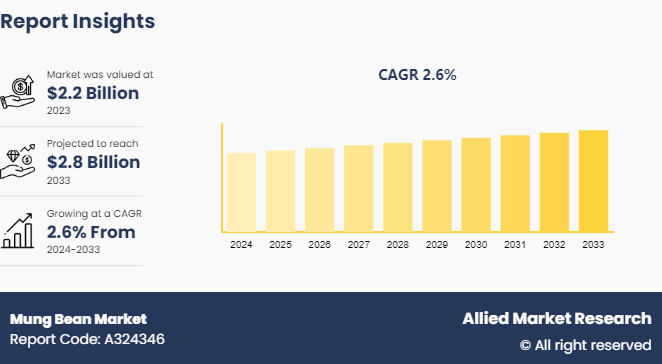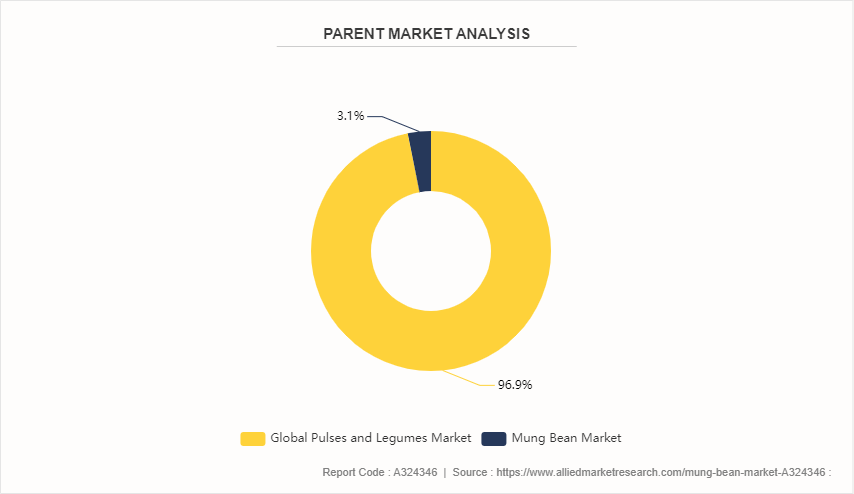Mung Bean Market Research, 2033
Market Introduction and Definition
The global mung bean market size was valued at $2.2 billion in 2023, and is projected to reach $2.8 billion by 2033, growing at a CAGR of 2.6% from 2024 to 2033. The term "mung bean market" describes the global trade and production of mung beans, a small, green legume commonly cultivated in Asia and other tropical and subtropical areas. Mung beans are a staple in many traditional cuisines and an essential component of processed foods such as noodles, sprouts, and snacks due to their high nutritional content, which includes proteins, fibers, vitamins, and minerals. Furthermore, the surge in consumer demand for plant-based proteins, health-conscious eating patterns, and the acceptance of vegetarian and vegan diets are the main drivers of the industry growth. It is utilized as a cover crop and in animal feed. It improves soil fertility and supports sustainable farming methods.

Key Takeaways
- The mung bean market study covers 20 countries. The research includes a segment analysis of each country in terms of value ($Billion) for the projected period 2024-2033.
- More than 1, 500 product literature, industry releases, annual reports, and other such documents of major mung bean industry participants along with authentic industry journals, trade associations' releases, and government websites have been reviewed for generating high-value industry insights.
- The study integrated high-quality data, professional opinions and analysis, and critical independent perspectives. The research approach is intended to provide a balanced view of global markets and assist stakeholders in making educated decisions to achieve their most ambitious growth objectives.
Key market dynamics
Numerous key factors impact the mung bean market, influencing its growth and development. Growing customer demand for plant-based proteins due to increased knowledge of their health advantages and sustainability as a source of food is a major motivator. Mung beans are becoming a more common component of diets around the world, particularly in areas where plant-based diets are more common due to their high protein content, low fat level, and rich nutrient profile. Furthermore, the market for products made from mung beans is growing as the number of vegans and vegetarians rises.
The growth of mung bean applications beyond traditional consumption is another important trend. Mung beans have become a staple in plant-based meat substitutes and processed food products including noodles, soups, and snacks. The market has expanded due to the diversification of applications, especially in North America and Europe where there is a high demand for novel culinary products.
In addition, supply chain factors and agricultural methods are quite important. China and India are the two largest suppliers of mung beans, which are primarily cultivated in Asia. Agri-environmental factors that impact crop productivity, such as soil health and climate, impact the market. Sustaining product quality and satisfying global consumer demand depends on supply chain efficiency, which includes developments in processing and distribution.
The market does, however, encounter challenges, including pricing volatility for raw materials and competition from other legumes and pulses. Furthermore, even though mung beans are well known to provide health benefits, some areas still need to raise consumer knowledge to stimulate demand.
The surge in emphasis on sustainable agriculture, innovative product development, and healthy eating drives the mung bean market expansion. The market is expected to witness steady demand and growth as customers look for nutrient-dense, environmentally friendly food options.
Parent Market Overview of the Global Mung Bean Market
The pulse and legume market, a significant sector of the global agricultural and food business, includes the global mung bean market. Mung beans are one of the many types of pulses that are valued for their high protein content, low cost, and wide range of culinary uses. The parent market has grown due to the popularity of sustainable and ecologically friendly food sources, health & wellness trends, and a rise in consumer demand for plant-based proteins. In many parts of the world, especially Asia and Africa, where pulses are staple foods, they are essential for food security. Apart from agricultural techniques, government regulations that support pulse growing and advancements in food processing and product development have an impact on the market. These factors contribute to the increased popularity of pulses such as mung beans.

Market Segmentation
The mung bean market is segmented into type, distribution channel, and region. By type, the market is divided into GMO seeds and non-GMO seeds. By distribution channel, the market is bifurcated into online and offline. Region wise, the market is analyzed across North America, Europe, Asia-Pacific, and LAMEA.
Regional/Country Market Outlook
The growing need for plant-based protein sources, the health advantages of mung beans, and their many culinary uses are propelling the steady rise of the global mung bean market. The Asia-Pacific region continues to be the largest market for mung beans with nations such as China, India, and Myanmar leading the industry in both production and consumption. Mung beans are an integral part of many traditional Indian cuisines and daily diets. Mung beans are becoming more in mung bean market demand as people become more aware of their nutritional advantages. Another significant participant is China, which serves both domestic and foreign markets by being a top producer and exporter of mung beans.
In addition, mung beans are an essential part of the diets and agricultural methods of several Southeast Asian nations, including Vietnam and Thailand. The environment in the region is ideal for growing mung beans, so there is constantly a supply.
Furthermore, the growing demand for sustainable and healthy food sources is driving a slow but steady expansion of the mung bean market across the Middle East and Africa. Growing knowledge of the health advantages of mung beans is driving up customer base growth in countries such as South Africa and Egypt.
Moreover, the growth of the mung bean market in Europe and North America is driven by the rise in the number of vegans and vegetarians as well as the desire for high-protein, gluten-free foods. Mung beans are being utilized more often in plant-based food products, such as snacks and meat alternatives, with the U.S. and Germany being two of the major markets in these regions.
As a result, the mung bean market is expected to expand throughout the globe due to ideal farming circumstances, rising consumer health consciousness, and a global shift toward plant-based and sustainable diets. The market is anticipated to continue growing as customer preferences change, especially in regions where mung beans are becoming more popular as nutritious foods.
Industry Trends:
- A new line of mung bean-based snacks was introduced by an American organic food manufacturer in April 2024 with a view toward the plant-based protein industry and health-conscious consumers.
- Mung bean protein powders were added to the product line of an American health food firm in October 2023 in response to the growing need for substitute protein sources.
- Chinese mung bean exports increased significantly in January 2024, especially to neighboring Asian nations, as a result of the growing demand for mung bean-based products in the region.
- A multinational food corporation, aiming to satisfy the growing demand from vegan and lactose-intolerant consumers, launched a range of plant-based beverages derived from mung beans in the Asia-Pacific market in June 2024.
- In November 2023, the Asia-Pacific region adopted precision farming to increase mung bean harvests while cutting production costs.
Competitive Landscape
The major players operating in the mung bean market include Australian Mungbean Company, Gaurav International Limited, Arkar Oo Co., Ltd., Geo Agrotech, YC Consumer Goods Private Limited, Agrochiminvest, Pulses Exp. Co., Ltd., Shanxi Xinfei Agriculture Development Co. Ltd, Asia-Trade, and Yesraj Agro Exports Pvt. Ltd.
Recent Key Strategies and Developments
- In September 2023, a new sustainable farming project by Geo Agrotech was introduced to reduce the environmental impact of mung bean agriculture. Adoption of organic fertilizers and water-efficient irrigation techniques are part of the scheme. The company's objectives of sustainability and innovation are aligned with this program, which is anticipated to enhance agricultural yields and improve soil health. The initiatives taken by Geo Agrotech show their commitment to environmental care and their foresight in addressing the impact of climate change on agriculture.
- In March 2023, Gaurav International Limited introduced a new brand of organic mung beans to appeal to health-conscious customers and broaden its product offering. The increased demand for food products that are obtained responsibly and organically is in by this effort. To guarantee superior yields and encourage environmental sustainability, the corporation invested in innovative farming methods. Their broader plan includes this action to fortify their position in the market and cater to the growing demand for organic foods among consumers.
Key Benefits For Stakeholders
- This report provides a quantitative analysis of the mung bean market share, segments, current trends, estimations, and dynamics of the mung bean market analysis from 2024 to 2033 to identify the prevailing mung bean market opportunities.
- The market research is offered along with information related to key drivers, restraints, and opportunities.
- Porter's five forces analysis highlights the potency of buyers and suppliers to enable stakeholders make profit-oriented business decisions and strengthen their supplier-buyer network.
- In-depth analysis of the mung bean market forecast and mung bean market segmentation assists to determine the prevailing market opportunities.
- Major countries in each region are mapped according to their revenue contribution to the global market.
- Market player positioning facilitates benchmarking and provides a clear understanding of the present position of the market players.
- The report includes the analysis of the regional as well as global mung bean market trends, key players, market segments, application areas, and mung bean market growth strategies.
Mung Bean Market Report Highlights
| Aspects | Details |
| Market Size By 2033 | USD 2.8 Billion |
| Growth Rate | CAGR of 2.6% |
| Forecast period | 2024 - 2033 |
| Report Pages | 250 |
| By Type |
|
| By Distribution Channel |
|
| By Region |
|
| Key Market Players | Asia-Trade, YC Consumer Goods Private Limited, Geo Agrotech, Arkar Oo Co., Ltd, Agrochiminvest, Shanxi Xinfei Agriculture Development Co. Ltd, Gaurav International Limited, Pulses Exp. Co., Ltd., Australian Mungbean Company, Yesraj Agro Exports Pvt. Ltd. |
The global mung bean market is seeing trends like increasing demand for plant-based protein, organic and sustainable farming practices, rising use in vegan products, and expanding applications in health foods and beverages.
The leading application of the mung bean market includes food products such as sprouted beans, flour, and snacks, along with use in traditional medicine and as a protein source in vegetarian diets.
Asia is the largest regional market for mung beans, with significant production and consumption in countries like India, China, and Myanmar, driven by rising demand for plant-based protein and health foods.
The global mung bean market was valued at $2.2 billion in 2023, and is projected to reach $2.8 billion by 2033, growing at a CAGR of 2.6% from 2024 to 2033.
The major players operating in the mung bean market include Australian Mungbean Company, Gaurav International Limited, Arkar Oo Co., Ltd., Geo Agrotech, YC Consumer Goods Private Limited, Agrochiminvest, Pulses Exp. Co., Ltd., Shanxi Xinfei Agriculture Development Co. Ltd, Asia-Trade, and Yesraj Agro Exports Pvt. Ltd.
Loading Table Of Content...



